Abstract
Manufacturing quality cost optimization is a priority in any manufacturing sector due to quality issues impacting companies’ reputations and has financial consequences. Quality costs are composed of tangible and intangible costs, however, only tangible costs used to be analyzed because there is no suitable methodology for measuring intangible costs. In this context, an innovative decision support system is developed with an empirical base, applying Analytical Hierarchy Process (AHP), Analytical Network Process (ANP), and Lean methodology to reduce all quality costs in an efficient way. In quality departments, perceptions, thoughts, and judgments (intangible costs) are not measured and controlled. This study develops an innovative methodology that allows to address this issue in an effective way. Another major innovation is the application of both multi-criteria methodologies to obtain the best combined result for decision making and the optimization of this result, developing an effort–impact matrix based on Lean manufacturing methodology. This system speeds up the decision-making process and assures its efficiency for quality department applications. Moreover, this decision support system may be applicable to any manufacturing sector.
1. Introduction
Traditional cost analyses in manufacturing areas are not designed to collect certain groups of quality costs [1,2,3,4], such as intangible costs that have marked subjective and qualitative characters. Quality departments are used to disregard intangible costs because there are no efficient methodologies to measure and control them. Thereby, the real amount of quality costs used to be hidden in the total costs of companies.
To achieve the zero-defect standard [1,2,3,4] and customer satisfaction, all costs must be controlled, and those companies that have high quality costs are losing competitiveness and their reputation may be seriously affected. In this environment, the companies that are willing to detect all quality costs and look for an optimal and quick solution will be in a competitive advantage position in comparison with their competitors.
Some authors highlight the complexity of measuring all quality costs and the lack of information as the key challenges and issues. Other researchers note the high investment needed to identify and correct all quality issues to achieve a zero-defect standard as the major constraint [1,2,3,4]. For the above, it is identified as a necessity in manufacturing companies that is not covered by the scientific community yet. The objective of this study is to develop a disruptive decision support system [5,6,7,8] that provides for any manufacturing company an innovative tool to measure and control intangible and tangible costs in quality departments. Furthermore, the aim of this tool will be the prioritization of reengineering actions that should be taken in quality departments in order to improve quality levels with a sustainable cost for manufacturing companies
After researching several methods, a multi-criteria analysis was found [9,10,11,12,13,14,15,16] that uses the numerical scale of Saaty, to expose perceptions, thoughts, judgments, as well as to measure, with the same criteria, tangible and intangible qualities. Due to this fact, we decided to apply two multi-criteria analysis processes to measure and control all quality costs (intangible and tangible costs) in manufacturing plants.
Not only is the concept of applying multi-criteria analysis to quality cost innovative, but also the application of Lean methodology [17,18,19,20,21] to optimize the results of the two different multi-criteria analyses. This system will offer a disruptive and complete solution that allows to address the issue exposed and facilitates decision making.
It is not trivial that companies look for cost-efficient solutions and this study is aligned with this approach. Consequently, the study covers cost effectiveness, designing an application based on Lean methodology, an effort–impact matrix, that will prioritize those results that with the lowest effort will have the highest impact for the manufacturer. This decision support system will provide to the steering committee enough information in a timely manner to act on those quality issues with the biggest impact and the lowest effort and cost.
For the above, the layout of this article is as follows: firstly, data was downloaded from the ERP of a manufacturing company, to obtain the list of parts with incidents during the 2-year warranty period, the financial impact, and number of incidents by part (tangible costs). Additionally, the Delphi method [22] was applied, sending surveys to several stakeholders within the company to identify intangible costs. With the previous information, Analytic Hierarchy Process (AHP) [9,10,11,12,13,14,15,16] and Analytic Network Process (ANP) [23,24] were implemented. Each process had their own results. A comparison and complete result analysis was undertaken to grant the most efficient results. Finally, results of multi-criteria analysis were optimized by applying an effort–impact matrix based on Lean methodology to obtain the final result and consequently the most efficient decision in terms of quality improvement and reengineering.
2. Analytic Hierarchy Process (AHP) Implementation
Tomas L. Saaty (T. L. Saaty 1980) developed a method, the Analytic Hierarchy Process (AHP) [9,10,11,12,13,14,15,16], to solve problems with different criteria and several alternatives and all of them should be considered to achieve an accurate outcome. This method of multi-criteria decision making is characterized by the fact that it decomposes the issue visually into a hierarchical structure. Comparisons in pairs determines the importance and influence of the factors that compose the problem, issuing judgments of value that allow to compare, with the same scale, quantitative and qualitative factors. Additionally, it verifies the consistency of the value judgments, providing security in the decision making.
It incorporates aspects of qualitative and quantitative human thinking, defining the problem and establishing the hierarchy and expressing judgments and preferences in a concise way.
For exposing perceptions, thoughts, and judgments, as well as to measure with the same criteria tangible and intangible qualities, the numerical scale of Saaty was applied and this scale is represented in Table 1. More importantly, numerical scales allow to project alternatives on a common scale.

Table 1.
Saaty’s fundamental scale.
The AHP process consists of three phases reflected in Figure 1.

Figure 1.
Phases of AHP.
2.1. Structure of the Problem
Alternative definitions were obtained through the ERP system of a manufacturer. The report indicated the parts with the highest failure rates during the first 2 years of the lifecycle of several parts. Alternatives were the 10 parts with the highest financial impact and number of incidents. The list of parts selected is shown in Table 2.

Table 2.
Top ten parts (alternatives).
Definition of the criteria (intangible costs) was obtained through the Delphi method [22]. A survey was sent out to be completed by managers of a manufacturing organization. Managers should choose different criteria based on their own knowledge about the impact that any quality issue in products (parts) may have. Criteria selected by managers are shown in Table 3.

Table 3.
List of intangible costs and impacts (criteria).
Once criteria and alternatives were determined, the hierarchy of the AHP process was created. The hierarchy structure is shown in Figure 2.
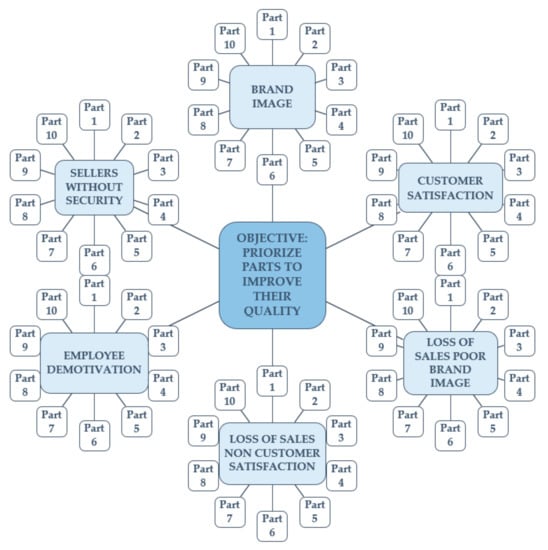
Figure 2.
Hierarchy scheme of the AHP process.
2.2. Determination of Properties and Consistency with an Automatized Computer Application
The application developed in Microsoft Excel 2013, allows to collect the judgments issued by several managers of the manufacturer and make comparisons between criteria and alternatives. Once all the judgments were determined using the Saaty scale (Table 1), this application obtained the priorities automatically from the judgments given, using a method of approximation.
The matrix of paired comparisons for the criteria and alternatives is based on the four axioms below [25]:
Axiom 1—Reciprocity: reciprocal judgments.
Axiom 2—Homogeneity: the elements that are compared have the same order, magnitude, or hierarchical level.
Axiom 3—Dependence: there is hierarchical dependence between the elements of two consecutive levels.
Axiom 4—Consistency: when the matrix of paired comparisons is perfectly consistent, it follows that:
i: rows in matrix of pairwise comparison.
aij = 1/aji
j: columns in matrix of pairwise comparison.
aij are the elements of comparison matrices that express the preferences when applying the Saaty Scale. Elements of row i are compared with the elements of column j. For instance, when i = j aij = 1, the element is compared with itself.
The structure of the criteria and alternative comparison matrices are shown in Figure 3 and Figure 4 below.

Figure 3.
Example of criteria comparison matrix.

Figure 4.
Example of alternative comparison matrix (brand image).
The Excel application automatically calculates the consistency of the judgments for each matrix of the criteria and alternatives, this application is shown in Figure 5. As results obtained should assure validity for decision making, it is imperative to demonstrate whether the judgments issued by the managers are consistent or not.
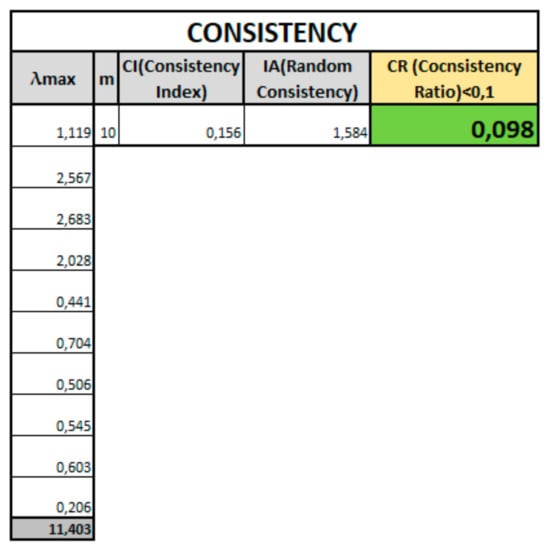
Figure 5.
Example of consistency of the judgments.
In a matrix that is completely consistent, axiom 4 must be satisfied.
This property requires all columns of a matrix to be dependent. The columns in any (2 x 2) comparison matrix are totally dependent, so they are always consistent.
For the remaining m x m matrices, it is very likely that there is some degree of inconsistency. The Hierarchical Analytical Process allows to measure the inconsistency of the judgments through the proportion or ratio of consistency (CR). For (3 x 3) matrices the value of the consistency ratio should not exceed 5%, should not exceed 9% in the case of (4 x 4) matrices, and for the rest of the matrices should be 10% or less.
The closer to the above-mentioned values, the more consistent the judgments established in paired comparisons will be. If these values are exceeded, it means that the judgments are inconsistent and random, so they must be reviewed and corrected. The following formulas show the consistency calculation [25].
IA: random consistency index [25].
m: total elements compared.
λmax = matrix of paired comparisons x average vector of standardized matrix of paired comparisons.
2.3. Final Result of AHP
Another Excel sheet that performed the calculation of the result of the AHP was designed. An example of the AHP result is shown in Table 4 and Figure 6.

Table 4.
Example of the AHP result of a manager.
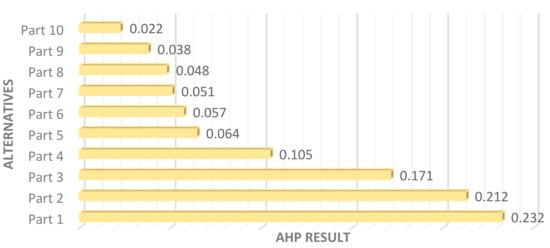
Figure 6.
Example of the AHP result of a manager.
Finally, a tool was designed to compare the results of the AHPs of each manager and to calculate the final result of the AHP and its robustness. Comparative results and robustness analysis are represented in Table 5 and Table 6, respectively. The final result of the AHP was calculated using the truncated mean statistics formula below:

Table 5.
Comparative results for each AHP.

Table 6.
Robustness analysis and final result of AHP.
xi: each result of the AHPs.
p: % of results that will be trimmed.
n = total number of results.
g = p * n.
3. Analytic Network Process (ANP) Implementation
After implementing the AHP process, the Analytic Network Process (ANP) [23,24] was developed.
In contrast with AHP, the ANP process represents a multi-criteria discrete problem in a network structure, where an interrelationship between all the elements appears that compounds the issue. As this process considers more interrelationships compared with AHP, it will give a more complicated solution, however, may be more realistic.
The ANP process is represented by elements or nodes gathered in components, groups, or clusters as is shown in Figure 7. An element in a group or cluster may influence elements within the same group or in other groups in the network. The name of the relationship between elements of the same group is feedback and the relationship between elements of different clusters is called interdependence.
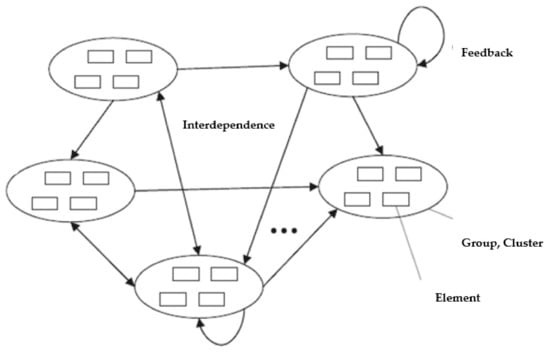
Figure 7.
Network structure of ANP.
Application of the ANP Process
The ANP process [23,24] was implemented to solve the same problem exposed with the AHP process. The ANP process is composed of seven main steps that were modeled with the free software “Superdecisions” (https://superdecisions.com, accessed on 11 December 2021). As a starting point, the same 10 alternatives and 6 criteria identified for the AHP process were applied.
- 1.
- Alternatives were gathered in a cluster and criteria in another cluster. For building the network, interrelationships between intangible criteria, interdependence between alternatives, and dependance between criteria and alternatives were considered. Once these interrelationships were established, the ANP scheme was implemented and this ANP structure is represented in Figure 8.
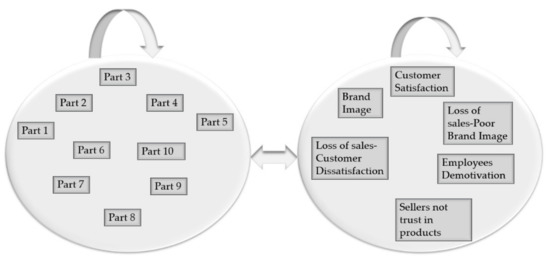 Figure 8. Network structure of ANP.
Figure 8. Network structure of ANP. - 2.
- The interfactorial dominance matrix shows what elements have a relationship. Interfactorial dominance matrix is shown in Table 7. In this matrix, those elements with a dominance relationship are represented by a “1” and elements with no relationship by a “0”. For instance, if Part 1 has a quality issue, two criteria will be impacted, Customer Satisfaction and Loss of Sales due to Customers Dissatisfaction and may cause failures in Parts 5 and 10. the relationship with itself is always represented by “1”.
 Table 7. Interfactorial dominance matrix.
Table 7. Interfactorial dominance matrix. - 3.
- The ANP process will have more matrices of paired comparisons than AHP due to the interrelationships between criteria and alternatives.
- 10 matrices of paired comparisons for feedback of alternatives.
- 6 matrices of paired comparisons between criteria and alternatives.
- 6 matrices of paired comparisons between criteria and other criteria.
- 4.
- Supermatrix not weighted or original: represents the related influence of the elements positioned in rows over the elements positioned in columns. Original matrix is represented in Table 8.
 Table 8. Original matrix.
Table 8. Original matrix. - 5.
- Stochastic weighted supermatrix: for calculating this matrix, blocks of the original supermatrix were weighted by applying the weight of each component.
- 6.
- Limit supermatrix: should be calculated by applying the stochastic weighted supermatrix to the power of n until the elements converge and remain stable. All the columns will be equal and their values will indicate the priority of the elements in the ANP network. Limit supermatrix is shown in Table 9.
 Table 9. Limit supermatrix.
Table 9. Limit supermatrix. - 7.
- Any column of the limit supermatrix represents the result of the ANP. The outcome reflects what parts should be a priority to take re-engineering actions for quality improvement. ANP result is shown in Table 10.
 Table 10. ANP result.
Table 10. ANP result.
4. ANP and AHP Result Comparison
Comparing results, Parts 3 and 4 are in the top 4 ranking in both methods, so it may be established that their prioritization is highly reliable.
In ANP, Part 8 appears as the main priority when in AHP was not in top 4 priorities, meaning that Part 8 has a high influence on the failure of the remaining parts and has a high influence on criteria as well. If this part has a failure, the remaining parts may fail because of its defect and this component might have a high impact on intangible criteria such as customer satisfaction, brand reputation, etc. This significant appreciation is only reflected in the ANP process because, as was mentioned in point 3, this process applies more interrelationships compared with AHP, providing a more realistic result.
Analyzing annual warranty cost and intangible cost by applying AHP and ANP processes, it was proved that:
- The AHP prioritization reduces the annual warranty cost (EUR 2.2 M-18.45%) more than ANP (EUR 1.6 M-13.36%).
- The ANP prioritization reduces a greater number of failures (3.189–5.12%) than AHP (1.483–2.83%).
Previous ANP and AHP result comparison is shown in Table 11.

Table 11.
Comparison ANP and AHP results.
5. Lean Methodology: Effort–Impact Matrix Application for Decision Making
Lean methodology [17,18,19,20,21] has several principles. In this study, one of them was applied: optimizing the whole, the objective of which is to optimize the value stream of any process. Every business represents a value stream which is the sequence of activities required to design, produce, and deliver a product or service to customers, in this study the value stream is to deliver an efficient and fast result, deciding what parts will be prioritized for improving quality levels. Then the value stream defined in the study should be optimized.
The main tool used to optimize the result of the AHP and ANP was an effort–impact matrix.
The effort–impact matrix is a Lean tool used mainly by businesses to set priorities and determine ideas, strategies, and projects that will provide the best solutions. It is applied when facing multiple options for solutions to a specific issue. It provides a visual image about potential work and the expected benefit and determines the return of investment in an efficient way.
Once parts to be improved were selected through multi-criteria analysis methods, an additional parameter was introduced, re-engineering cost of the parts selected, to focus the effort on those parts with low economic impacts for re-engineering that will cause a high impact for the customers. Re-engineering cost and AHP and ANP results are shown in Table 12. Re-engineering costs of each part were estimated by engineering and design departments of the manufacturer and the figures were extracted from the ERP of the manufacturing company.

Table 12.
Re-engineering cost and multi-criteria analysis results.
An effort–impact matrix was designed, where the cost of re-engineering of each part was considered as the effort and the result of the AHP or ANP for each part was the impact.
Each part was located in the matrix depending on its costs for reengineering and its prioritization ranking in AHP and ANP methods.
In the matrix shown in Figure 9, the parts located in the top right area were “the quick wins” and it meant that with low reengineering cost, the manufacturing plant will have a high impact in terms of quality improvements and consequently in customer satisfaction.
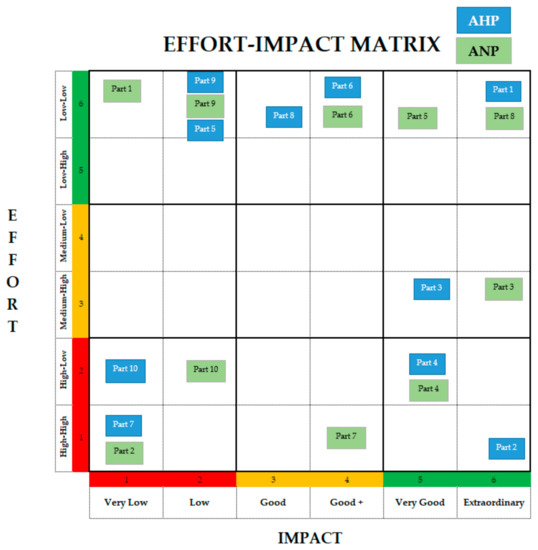
Figure 9.
Effort–impact matrix.
After analyzing the effort–impact matrix results, it may be stated that the quality department should prioritize Parts 1, 8, and 5 to apply re-engineering, as a second priority Parts 3 and 4 should be improved.
Comparing the effort–impact matrix result with the ANP and AHP combined result, Part 2 was excluded, which has a very high reengineering cost of EUR 2.380.000, warranty cost of EUR 575.147, and number of incidents of 245, so applying improvements in this part has reengineering costs that are too high with low return of investment. This proves that the Lean effort–impact matrix maximized and optimized the result of the multi-criteria analysis.
Therefore, Parts 1, 8, 5, 3, and 4 should be the priority for the quality department, applying the reengineering processes with an outcome that will result in savings of EUR 2.2 M-18.5% of the total warranty cost in two years and will reduce the number of incidents in 4.048–7.7% of the total incidents in two years. The reengineering cost for improving quality levels of these parts is EUR 3.3M, so the investment in reengineering will be amortized in 3 years approximately. Result is represented in Table 13.

Table 13.
Result (parts prioritized) and financial statement.
6. Discussion
The aim of this study was to develop a decision-making system that prioritizes the actions in quality departments within manufacturing plans, considering the total cost of the quality (tangible and intangible cost) and optimizing reengineering cost, time to market, and improving customer satisfaction. This study is scalable due to the applicability in manufacturing plants of any sector and was proven in the automotive industry
Other authors indicate the complexity of measuring all quality costs, especially intangible costs and the high cost that reengineering would cause if the entire problem of quality is addressed.
Nevertheless, both issues pointed out by other researchers were covered in this study in a novel way. A method to measure all quality costs through multi-criteria analysis and optimization of reengineering cost was found and undertaken using an effort–impact matrix.
This innovative study combined two multi-criteria methods, AHP and ANP. These methods allow to include intangible cost in analyses of the root cause of quality issues. As it was mentioned, in quality departments only tangible cost is used for analysis as there is no available methodology for analyzing intangible ones and by not analyzing all quality costs, manufacturing plants are in a competitive disadvantage.
Owing to the complexity and the importance of the problem, a complete decision support system based on multi-criteria analysis was developed. Two different multi-criteria processes (AHP and ANP) were applied to achieve the most efficient result, combining the results of both methods. This approach is totally innovative, analyzing the results of both processes and choosing a combined result that maximizes and improves the outcomes.
The result of the AHP process prioritizes Parts 1, 2, 3, and 4. ANP prioritizes Parts 8, 3, 4, and 5. Therefore, both processes have a common result prioritizing Parts 3 and 4, so based on the previous analysis it may be stated that an appropriate decision will be found for improving quality levels in Parts 3 and 4, due to both methods determining the same outcome.
After applying multi-criteria processes, the last significant parameter was introduced which was the cost of reengineering to improve quality in the parts.
As all manufacturing plants have limited resources, they must invest in the most efficient actions. Based on the previous affirmation a Lean manufacturing tool, effort–impact matrix, was implemented to select the parts that will be more efficient if they are eligible for re-engineering actions. The result of the effort–impact matrix shows that the priority should be Parts 1, 8, and 5. If the manufacturing company prioritizes re-engineering actions in these parts, a significant improvement in terms of quality levels and customer satisfaction will be obtained with the lowest investment in reengineering.
Parts 1, 8, and 5 were also included in the top 4 priorities of the AHP and ANP processes.
7. Conclusions
In conclusion, it may be stated that the parts that should be prioritized first are Parts 1, 8, and 5 and the second priority should be Parts 3 and 4. Once these parts are improved with reengineering processes, the manufacturing plant will obtain a cost avoidance due to the 2 years warranty cost of EUR 2.2 M (18,5% of the total warranty cost) with a reengineering cost of EUR 3.3 M, which will be amortized in 3 years approximately.
It may be stated that the objectives set were achieved. A methodology for decision-making was designed that controls, measures, and takes into account all quality costs (tangible and intangible). Application of the multi-criteria analysis processes, AHP and ANP, was achievable.
When manufacturing companies identify and reduce all quality costs, they are closer to a zero-defect standard and in a better competitive position, and this study facilitates that.
Another main objective achieved was quality cost optimization, through the application of an effort–impact matrix, which is based on Lean methodology. Using this, quality departments’ investment in re-engineering will be efficiently assigned for the most effective actions, reducing quality costs in the short- and mid-terms.
New areas for future research were identified, such as the application of Big Data to customer surveys for selection of intangible costs (criteria) for AHP and ANP, from the point of view of the final customer, instead of using Delphi methodology with employees within the manufacturing company. This change in the approach of the study, could be interesting for improving customer satisfaction and brand image even more.
Author Contributions
Conceptualization, methodology, investigation, writing—original draft preparation, and visualization, L.P.-F.; conceptualization, methodology, investigation, and writing—review and supervision, M.A.S.; conceptualization, methodology, investigation, and writing—review and supervision, C.G.-G. All authors have read and agreed to the published version of the manuscript.
Funding
This research was funded by the Annual Grant ICF01-2021; ETS Ingenieros Industriales. Universidad Nacional de Educación a Distancia (UNED).
Institutional Review Board Statement
Not applicable.
Informed Consent Statement
Not applicable.
Data Availability Statement
The data presented in this study is available within this article.
Acknowledgments
This paper was produced within the scope of the doctoral activities carried out by the lead author at the Escuela Internacional de Doctorado de la Universidad Nacional de Educación a Distancia (UNED). The authors are grateful for the support provided by this institution.
Conflicts of Interest
The authors declare no conflict of interest.
References
- Eleftheriadis, R.; Myklebust, O. A guideline of quality steps towards zero defect manufacturing in industry. In Proceedings of the International Conference on Industrial Engineering and Operations Management, Kuala Lumpur, Malasya, 8–10 March 2016; pp. 332–340. [Google Scholar]
- Psarommatis, F. Product quality improvement policies in Industry 4.0: Characteristics, enabling factors, barriers, and evolution toward Zero Defect Manufacturing. Data-Driven Cognitive Manufacturing-Applications in Predictive Maintenance and Zero Defect Manufacturing. Front. Comput. Sci. 2020, 2, 26. [Google Scholar]
- Psarommatis, F. Zero defect manufacturing: State-of-the-art review, shortcomings and future directions in research. Int. J. Prod. Res. 2020, 58, 1–17. [Google Scholar]
- Ferretti, S. Monitoring systems for zero defect manufacturing. Procedia CIRP 2013, 12, 258–263. [Google Scholar]
- Pérez-Fernández, L.; Sebastián, M.A.; González-Gaya, C. Decision support system to implement quality improvements optimazing tangible and intangible costs in manufacturing. In Proceedings of the 25th International Congress on Project Management and Engineering, Alcoi, Spain, 7–10 July 2020. [Google Scholar]
- Pérez-Fernández, L.; Conde, J.; Sebastián, M.A. Decision support system to decrease warranty and intangible costs in automotive industry. Procedia Manuf. 2017, 13, 1143–1150. [Google Scholar] [CrossRef]
- Dyer, R.F.; Forman, E.H. Group decision support with the Analytic Hierarchy Process. Decis. Support Syst. 1992, 8, 99–124. [Google Scholar] [CrossRef]
- Baccouche, A.; Goren, S.; Huyet, A.L.; Pierreval, H. An approach based on simulation optimization and AHP to support collaborative design: With an application to supply chains. In Proceedings of the 2011 IEEE Workshop on Computational Intelligence in Production and Logistics Systems (CIPLS), Paris, France, 11–15 April 2011. [Google Scholar] [CrossRef]
- Pereira, J.; Fragoso, M.; Todorov, M. Risk Assessment Using Bayesian Belief Networks and Analytic Hierarchy Process Applicable to Jet Engine High Pressure Turbine Assembly; Department of Systems and Control, National Laboratory for Scientific Computing: Petropolis, Brazil, 2016. [Google Scholar]
- Bahurmoz, A.M. The analytic hierarchy process at Dar AlHekma, Saudi Arabia. Interfaces 2003, 33, 70–78. [Google Scholar]
- Bascetin, A. An application of the analytic hierarchy process in equipment selection at Orhaneli open pit coal mine. Technical note. Min. Technol. Trans. Inst. Min. Metall. 2004, 113, 192–199. [Google Scholar]
- Claver, J.; García-Dominguez, A.; Sevilla, L.; Sebastián, M.A. A Multi-Criteria Cataloging of the Immovable Items of Industrial Heritage of Andalusia. Appl. Sci. 2019, 9, 275. [Google Scholar] [CrossRef] [Green Version]
- Beniak, J.; Šooš, L.; Križan, P.; Matúš, M. Implementation of AHP Methodology for the Evaluation and Selection Process of a Reverse Engineering Scanning System. Appl. Sci. 2021, 11, 12050. [Google Scholar]
- Alonso, J.A.; Lamata, M.T. Consistency in the analytic hierarchy process: A new approach. Int. J. Uncertain. Fuzziness Knowl. Based Syst. 2006, 14, 445–459. [Google Scholar] [CrossRef] [Green Version]
- Amenta, P.; Ishizaka, A.; Lucadamo, A.; Marcarelli, G.; Vyas, V. Computing a common preference vector in a complex multi-actor and multi-group decision system in Analytic Hierarchy Process context. Ann. Oper. Res. 2019, 284, 33–62. [Google Scholar] [CrossRef]
- Chen, C.F. Applying the analytical hierarchy process (AHP) approach to convention site selection. J. Travel Res. 2006, 45, 167–174. [Google Scholar] [CrossRef]
- Chow, D.; Smith, S.; Fau-Henwick, S.; Henwick, S. Applying Lean management to automation. MLO 2009, 41, 36–38. [Google Scholar]
- Abdulmalek, E.A. A Classification Scheme for the Process Industry to Guide the Implementation of Lean. Eng. Manag. J. 2006, 18, 15–25. [Google Scholar]
- Bevilacqua, M.; Ciarapica, F.E.; De Sanctis, I.; Mazzuto, G.; Paciarotti, C. A changeover time reduction through an integration of lean practices: A case study from pharmaceutical sector. Assem. Auto. 2015. [Google Scholar] [CrossRef]
- Ballé, M. The Lean Sensei. Go See Challenge; Lean Enterprise Institute, Inc.: Boston, MA, USA, 2019. [Google Scholar]
- Romero, D. Total Quality Management and Quality Circles in the Digital Lean Manufacturing World. In Proceedings of the IFIP International Conference on Advances in Production Management Systems, Austin, TX, USA, 1–5 September 2019. [Google Scholar]
- Kezar, A.; Maxey, D. The Delphi Technique: An Untapped Approach of Participatory Research; University South California: Los Angeles, CA, USA, 2014. [Google Scholar]
- Baviera-Puig, A.; García-Martínez, G.; Gómez-Navarro, T. Propuesta metodológica mediante ANP para la evaluación de las memorias de sostenibilidad del sector agroalimentario español. Econ. Agrar. Y Recur. Nat. 2014, 14, 81–101. [Google Scholar]
- Aznar, J.; Guijarro, F. Nuevos Métodos de Valoración. Modelos Multicriterio, 2nd ed.; Universitat Politècnica de València: Valencia, Spain, 2012. [Google Scholar]
- Hurtado, T.; Bruno, G. El Proceso Analítico Jerárquico (AHP) como Herramienta en la Toma de Decisiones en la Selección de Proveedores: Aplicación en la Selección del Proveedor para la Empresa Gráfica; Universidad Nacional Mayor de San Marcos. Facultad de Ciencias Matemáticas. EAP. Investigación Operativa; MYE S.R.L.: Lima, Perú, 2005. [Google Scholar]
Publisher’s Note: MDPI stays neutral with regard to jurisdictional claims in published maps and institutional affiliations. |
© 2022 by the authors. Licensee MDPI, Basel, Switzerland. This article is an open access article distributed under the terms and conditions of the Creative Commons Attribution (CC BY) license (https://creativecommons.org/licenses/by/4.0/).